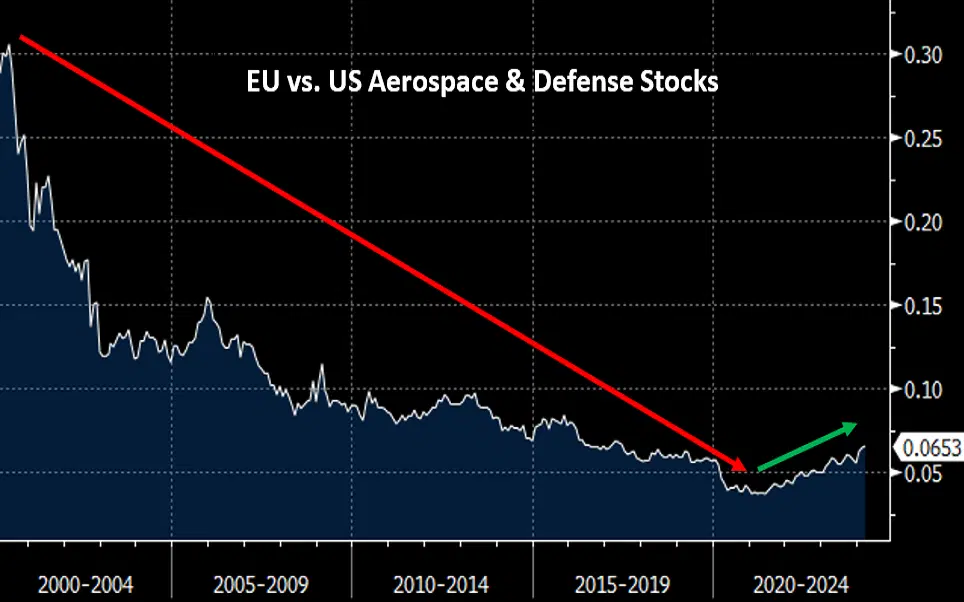Bigger military budgets create jobs but don’t necessarily lead to higher economic growth in richer nations. And they can actually be detrimental to growth in poorer countries.
Higher military spending can impact markets by increasing government bond yields and by reducing the risk of an invasion.
European defense stocks are outperforming their American counterparts, for the first time in a long time, as several European countries increase their military spending.
Countries poured a record $2.2 trillion into their defense budgets in 2023 – 9% more than the year before – as conflicts cranked up global tensions. And it’s bound to rise even higher, as Russia’s continued assault in Ukraine reminds even the most pacifist regions about the need for a military that can hold its own. What’s more, the result of the US presidential election could heap added pressure on NATO countries to allocate more money to defense. So let’s look at how this increased spending could impact economies and markets – and which companies might be set to profit.
How will more defense spending impact the economy?
Government spending is one of the four major components that drive the size of a country’s economy. Logically, then, the more military spending there is, the bigger the economy gets. Of course, the relationship isn’t that quite simple. Governments, ultimately, have finite budgets. So a heftier outlay in tanks, personnel, technology, and camo-patterned equipment generally has to be offset by lower spending elsewhere.
And because more money allocated to defense usually means less devoted to areas like infrastructure or education, some people argue that an increase in military spending can actually be harmful to long-term growth and development. But again, the relationship isn’t that simple. A study by The Economist found no consistent relationship between military spending and economic growth for the 38 mostly wealthy countries in the OECD.
That’s not to say there’s no relationship whatsoever. A 2014 study found that military spending in poorer countries often comes at the expense of economic expansion, whereas in more affluent countries, it’s more likely to stimulate it. And there are two possible explanations for this.
First, weaker oversight in developing countries makes big military budgets a juicy target for corrupt officials.
Second, in poorer countries, military spending has a higher “opportunity cost”, since it takes funds that might otherwise go to education, infrastructure, and other growth-producing areas. For richer, more developed countries, the opportunity costs are lower.
But there’s also another part of the economy that bigger military budgets can support: employment. And I’m not just talking about active military personnel, but also all the people employed by the industries militaries rely on, like weapons manufacturing, logistics, and so on. This is becoming even bigger these days as countries look long-term and invest in domestic weapons industries, rather than relying on manufacturers in other parts of the world.
How does this affect markets?
Those booming military costs have to be funded somehow, and that usually means bumping up government borrowing. And, the more government bonds are issued, the higher the yields they command. So there’s a more direct impact on the fixed-income (bond) market and a more indirect impact for other markets – since those higher yields may pull investors away from stocks, crypto, and other risky assets.
There’s another, more abstract potential impact here too: the idea that higher military spending might reduce the risk of conflict. It’s a lot more subtle and harder to measure, of course, but think of it like this: when a government spends big on its military and defense, it pays “dividends of deterrence”. That is, it makes the country less likely to be invaded or caught up in a war that causes its economy and markets to plunge. That’s important: a key element in any successful economy, after all, is the peace and stability that give people and businesses the confidence to invest.
What’s the opportunity here?
It’s been two years since Russia’s invasion of Ukraine. And Europe’s military industry has been booming, with aerospace and defense stocks in the bloc now outperforming their US counterparts (after more than two decades of being the underdogs). That makes sense, with the war in Ukraine and rising geopolitical tensions elsewhere boosting the order books of big, established defense companies and their suppliers.
And while European defense spending grew by 4.5% in 2023, average spending relative to the overall size of the bloc’s economy, at 1.6%, was still short of the 2% commitment set by NATO, which most European countries are part of. In other words, European nations need to boost their defense budgets by a quarter (on average) to fulfill their NATO obligations.

European aerospace and defense stocks used to widely underperform their US counterparts, but that’s changed dramatically over time. And in the past three years, they’ve been outperforming. Source: Bloomberg.
And that signals an investing opportunity. The problem is that there aren’t any ETFs purely focused on European aerospace and defense companies. There are, however, a few options that track global stocks in the sector, including the iShares Global Aerospace & Defence UCITS ETF (ticker: DFND; expense ratio: 0.35%), VanEck Defense UCITS ETF (DFNS; 0.55%), and Future of Defence UCITS ETF (NATO; 0.49%).
So one approach is to build a mini core-and-satellite portfolio of aerospace and defense stocks. The “core” portion, which is where you’d put the bulk of your allocation, might include one of the global ETFs above. The smaller, satellite portion, meanwhile, might include some European aerospace and defense stocks of your choosing, based on your own research.
Some of the biggest ones include Airbus, Safran, BAE Systems, Thales, Rheinmetall, Leonardo, Chemring, Dassault Aviation, Kongsberg Gruppen, and Saab. All of these names are benefiting from expanding European military budgets. Just look at Rheinmetall: the world’s leading maker of artillery ammunition recently said it expects its 2024 sales to grow by 40% to a record €10 billion ($10.9 billion).
-
Capital at risk. Our analyst insights are for information purposes only.





